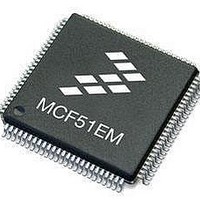MCF51EM128CLK Freescale Semiconductor, MCF51EM128CLK Datasheet - Page 203

MCF51EM128CLK
Manufacturer Part Number
MCF51EM128CLK
Description
IC MCU 32BIT 128KB FLASH 80LQFP
Manufacturer
Freescale Semiconductor
Series
MCF51EMr
Datasheets
1.MCF51EM128CLL.pdf
(2 pages)
2.MCF51EM128CLL.pdf
(54 pages)
3.MCF51EM128CLL.pdf
(636 pages)
Specifications of MCF51EM128CLK
Core Processor
Coldfire V1
Core Size
32-Bit
Speed
50MHz
Connectivity
I²C, SCI, SPI
Peripherals
LCD, LVD, PWM, WDT
Number Of I /o
56
Program Memory Size
128KB (128K x 8)
Program Memory Type
FLASH
Ram Size
8K x 8
Voltage - Supply (vcc/vdd)
1.8 V ~ 3.6 V
Data Converters
A/D 12x16b
Oscillator Type
External
Operating Temperature
-40°C ~ 85°C
Package / Case
80-LQFP
Processor Series
MCF51EM
Core
ColdFire V1
Data Bus Width
32 bit
Data Ram Size
16 KB
Interface Type
RS-232, LIN
Maximum Clock Frequency
50 MHz
Number Of Timers
3
Operating Supply Voltage
1.8 V to 3.6 V
Maximum Operating Temperature
+ 85 C
Mounting Style
SMD/SMT
3rd Party Development Tools
JLINK-CF-BDM26, EWCF
Development Tools By Supplier
TWR-MCF51CN-KIT, TWR-SER, TWR-ELEV, TOWER
Minimum Operating Temperature
- 40 C
Lead Free Status / RoHS Status
Lead free / RoHS Compliant
Eeprom Size
-
Lead Free Status / Rohs Status
Details
Available stocks
Company
Part Number
Manufacturer
Quantity
Price
Company:
Part Number:
MCF51EM128CLK
Manufacturer:
Freescale Semiconductor
Quantity:
10 000
- Current page: 203 of 636
- Download datasheet (11Mb)
All ColdFire processors use an instruction restart exception model. Exception processing includes all
actions from fault condition detection to the initiation of fetch for first handler instruction. Exception
processing is comprised of four major steps:
The table contains 256 exception vectors; the first 64 are defined for the core and the remaining 192 are
device-specific peripheral interrupt vectors. See
details on the device-specific interrupt sources.
For the V1 ColdFire core, the table is partially populated with the first 64 reserved for internal processor
exceptions, while vectors 64-102 are reserved for the peripheral I/O requests and the seven software
interrupts. Vectors 103–255 are unused and reserved.
Freescale Semiconductor
All ColdFire processors support a 1024-byte vector table aligned on any 1 MB address boundary (see
Table
0x(00)00_0000 in the flash or 0x(00)80_0000 in the internal SRAM.
•
•
1. The processor makes an internal copy of the SR and then enters supervisor mode by setting the S
3. The processor saves the current context by creating an exception stack frame on the system stack.
4. The processor calculates the address of the first instruction of the exception handler. By definition,
2. The processor determines the exception vector number. For all faults except interrupts, the
8-6). For the V1 ColdFire core, the only practical locations for the vector table are based at
A single exception stack frame format
Use of separate system stack pointers for user and supervisor modes.
bit and disabling trace mode by clearing the T bit. The interrupt exception also forces the M bit to
be cleared and the interrupt priority mask to set to current interrupt request level.
The exception stack frame is created at a 0-modulo-4 address on top of the system stack pointed to
by the supervisor stack pointer (SSP). As shown in
fixed-length stack frame for all exceptions. The exception type determines whether the program
counter placed in the exception stack frame defines the location of the faulting instruction (fault)
or the address of the next instruction to be executed (next).
the exception vector table is aligned on a 1 MB boundary. This instruction address is generated by
fetching an exception vector from the table located at the address defined in the vector base register.
The index into the exception table is calculated as (4 × vector number). After the exception vector
has been fetched, the vector contents determine the address of the first instruction of the desired
handler. After the instruction fetch for the first opcode of the handler has initiated, exception
processing terminates and normal instruction processing continues in the handler.
processor performs this calculation based on exception type. For interrupts, the processor
performs an interrupt-acknowledge (IACK) bus cycle to obtain the vector number from the
interrupt controller if CPUCR[IAE] is set. The IACK cycle is mapped to special locations within
the interrupt controller’s address space with the interrupt level encoded in the address. If
CPUCR[IAE] is cleared, the processor uses the vector number supplied by the interrupt controller
at the time the request was signaled for improved performance.
MCF51EM256 Series ColdFire Integrated Microcontroller Reference Manual, Rev. 8
Chapter 10, “Interrupt Controller (CF1_INTC)”
Figure
8-10, the processor uses a simplified
ColdFire Core
for
8-11
Related parts for MCF51EM128CLK
Image
Part Number
Description
Manufacturer
Datasheet
Request
R

Part Number:
Description:
IC MCU 32BIT 256KB FLASH 100LQFP
Manufacturer:
Freescale Semiconductor
Datasheet:

Part Number:
Description:
BOARD DEMO HARDWARE ONLY
Manufacturer:
Freescale Semiconductor
Datasheet:

Part Number:
Description:
IC MCU 32BIT 128KB FLASH 100LQFP
Manufacturer:
Freescale Semiconductor
Datasheet:

Part Number:
Description:
IC MCU 32BIT 256KB FLASH 80LQFP
Manufacturer:
Freescale Semiconductor
Datasheet:
Part Number:
Description:
Manufacturer:
Freescale Semiconductor, Inc
Datasheet:
Part Number:
Description:
Manufacturer:
Freescale Semiconductor, Inc
Datasheet:
Part Number:
Description:
Manufacturer:
Freescale Semiconductor, Inc
Datasheet:
Part Number:
Description:
Manufacturer:
Freescale Semiconductor, Inc
Datasheet:
Part Number:
Description:
Manufacturer:
Freescale Semiconductor, Inc
Datasheet:
Part Number:
Description:
Manufacturer:
Freescale Semiconductor, Inc
Datasheet:
Part Number:
Description:
Manufacturer:
Freescale Semiconductor, Inc
Datasheet:
Part Number:
Description:
Manufacturer:
Freescale Semiconductor, Inc
Datasheet:
Part Number:
Description:
Manufacturer:
Freescale Semiconductor, Inc
Datasheet:
Part Number:
Description:
Manufacturer:
Freescale Semiconductor, Inc
Datasheet:











